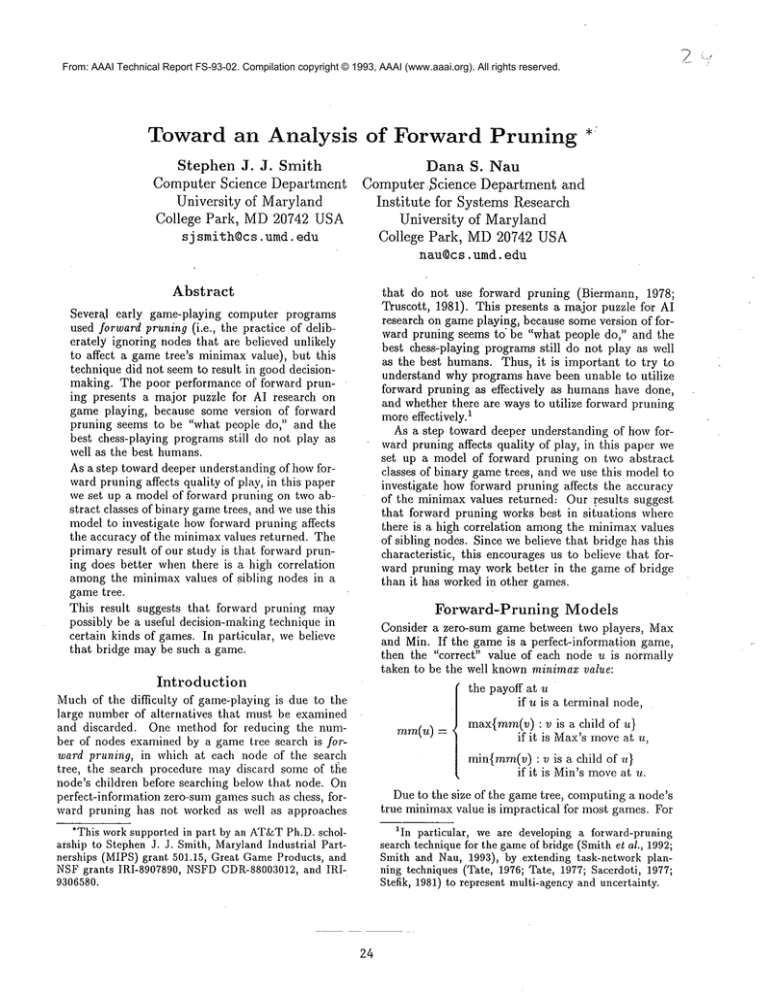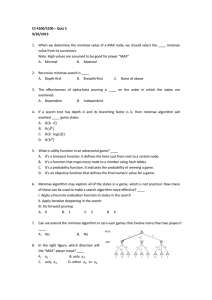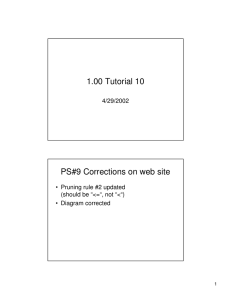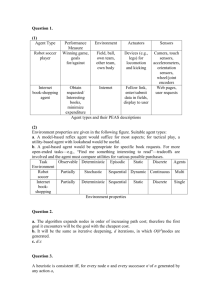
From: AAAI Technical Report FS-93-02. Compilation copyright © 1993, AAAI (www.aaai.org). All rights reserved.
Toward an Analysis
Stephen
J. J. Smith
Computer Science Department
University
of Maryland
College Park, MD 20742 USA
sj smith@cs, umd. edu
of
Forward
Pruning
:~<."
Dana S. Nau
Computer 3cience
Department
and
Institute
for Systems Research
University
of Maryland
College Park, MD 20742 USA
nau@cs, umd. edu
Abstract
that do not use forward pruning (Biermann, 1978;
Truscott, 1981). This presents a major puzzle for AI
research on game playing, because some version of forward pruning seems to" be "what people do," and the
best chess-playing programs still do not play as well
as the best humans. Thus, it is important to try to
understand why programs have been unable to utilize
forward pruning as effectively as humans have done,
and whether there are ways to utilize forward pruning
1moreeffectively.
As a step toward deeper understanding of how forward pruning affects quality of play, in this paper we
set up a model of forward pruning on two abstract
classes of binary gametrees, and we use this model to
investigate howforward pruning affects the accuracy
of the minimax values returned: Our results suggest
that forward pruning works best in situations where
there is a high correlation amongthe minimax values
of sibling nodes. Since we believe that bridge has this
characteristic, this encourages us to believe that forward pruning may work better in the game of bridge
than it has worked in other games.
Sever0,1 early game-playing computer programs
used forward pruning (i.e., the practice of deliberately ignoring nodes that are believed unlikely
to affect a game tree’s minimaxvalue), but this
technique did not seem to result in good decisionmaking. The poor performance of forward pruning presents a major puzzle for AI research on
game playing, because some version of forward
pruning seems to be "what people do," and the
best chess-playing programs still do not play as
well as the best humans.
As a step toward deeper understanding of howforward pruning affects quality of play, in this paper
we set up a model of forward pruning on two abstract classes of binary gametrees, and we use this
model to investigate how forward pruning affects
the accuracy of the minimaxvalues returned. The
primary result of our study is that forward pruning does better when there is a high correlation
amongthe minimax values of sibling nodes in a
game tree.
This result suggests that forward pruning may
possibly be a useful decision-making technique in
certain kinds of games. In particular, we believe
that bridge may be such a game.
Forward-Pruning
Models
Consider a zero-sum game between two players, Max
and Min. If the game is a perfect-information game,
then the "correct" value of each node u is normally
taken to be the well knownminimax value:
the payoff at u
if u is a terminal node,
Introduction
Muchof the difficulty of game-playing is due to the
large number of alternatives that must be examined
and discarded. One method for reducing the number of nodes examined by a game tree search is forward pruning, in which at each node of the search
tree, the search procedure may discard some of the
node’s children before searching below that node. On
perfect-information zero-sum games such as chess, forward pruning has not worked as well as approaches
mm(u)
max{ram(v): v is a child of l,}
if it is Max’smoveat u,
min{mm(v):v is a child of u}
if it is Min’s moveat u.
Due to the size of the gametree, computinga node’s
true minimax value is impractical for most games. For
*This work supported in part by an AT&T
Ph.D. scholarship to Stephen J. J. Smith, MarylandIndustrial Partnerships (MIPS)grant 501.15, Great GameProducts, and
NSFgrants IRI-8907890, NSFDCDR-88003012,and IRI9306580.
1In particular, we are developing a forward-pruning
search techniquefor the gameof bridge (Smith et al., 1992;
Smith and Nau, 1993), by extending task-network planning techniques (Tate, 1976; Tate, 1977; Sacerdoti, 1977;
Stefik, 1981) to represent multi-agencyand uncertainty.
24
From: AAAI Technical Report FS-93-02. Compilation copyright © 1993, AAAI (www.aaai.org). All rights reserved.
Max node
Min nodes
RVAnodes
Randomvalues
Maxnodes
::’
]
Min nodes
RVAnodes
Randomvalues
> ’
> 0
Max nodes
Leaf node values
>
1 1 1
1 0
1
o
1
2
1
2
1
2
0
0
0
0
1
2
Figure 1: Exampleof an N-game-like tree.
this reason, game-playing programs usually mark some
non-terminal nodes as terminal, and evaluate them using some static evaluation function e(u). The simplest
version of this approach is what Shannon (Shannon,
1950) called "Type A" pruning: choose some arbitrary
cutoff depth d, and mark a non-terminal node u as
terminal if and only if u’s depth exceeds d. A more sophisticated version of this is quiescence search: mark
a non-terminal node u as terminal if and only if u’s
depth exceeds d and u is "quiet" (i.e., there is reason
to believe that e(u) will be reasonably accurate at u).
To decrease the number of nodes examined even further, a number of game-tree-search procedures have
been developed such as alpha-beta (Knuth and Moore,
1975), B* (Berliner, 1979), or SSS* (Stockman, 1979).
These procedures will ignore any node v below u
that they can prove will not affect u’s minimaxvalue
The above approach has worked well in games
such as chess (Berliner et al., 1990; Levy and Newborn, 1982), checkers (Sanmel, 1967), and othello (Lee
and Mahajan, 1990). A more aggressive approach
is forward pruning, in which the procedure deliberately ignores v if it believes v is unlikely to affect
turn(u), even if there is no proof that v will not affect ram(u). Although several early computer chess
programs used forward pruning, this approach is no
longer widely used, because chess programsthat used it
did less well than those that did not (Biermann, 1978;
Truscott, 1981).
25
Our Model of Forwm’d-Pruning.
Our model of a
forward-pruning algorithm works as follows. At each
node u where it is Max’s moveor Min’s move, u has two
children, Ul and u2. The forward pruning algorithm
will choose exactly one of these two nodes to investigate
further. There are two possible cases:
1. Ul and u2 do not have the same minimax value.
Then the correct child to investigate further is the
one whose minimax value is the same as the minimax
value of u. Thus, for a Maxnode, the correct child
is the one with the higher value; for a Min node, the
correct child is the one with the lower value. If the
algorithm does not choose the correct child, it will
continue its search downan incorrect branch, which
is likely to result in an error in the algorithm’s computation of u’s minimax value. Weassume that the
algorithm’s probability of choosing the correct child
is p, where p is constant throughout the tree.
2. ul and u2 have the same minimax value. In this
case, we assume that the algorithm’s probability of
choosing Ul is 1~, and likewise for u2.
Game-Tree
Models
In this section, we define two different classes of game
trees. In later sections, we will investigate howforward
pruning behaves on these trees.
N-Game-Like "IYees. In this section, we define an
class of abstract gametrees that are similar to the Ngames described in (Nau, 1982; Nau, 1983). For this
From: AAAI Technical Report FS-93-02. Compilation copyright © 1993, AAAI (www.aaai.org). All rights reserved.
Max node
Min nodes
Maxnodes
Minnodes
Max nodes
>
Leaf node val~les
>
3
40
14
40
21
40
19
39 31
3
40 40 40 40-
16
40
12
40
33
40
10
40
i
31
40
6
40
36
40
36
40
Figure 2: Exampleof a P-game-like tree, with m= 40.
reason, we call them N-game-like trees. 2 Each N-gamelike tree is a complete tree that contains the following
types of nodes (an example appears in Fig. 1):
1. Maxnodes, where it is Max’s move. Each Maxnode
is either a leaf node or has exactly two children, both
of which are Min nodes.
2. Miu nodes, where it is Min’s move. Each Min node
has exactly two children, both of which are I~VA
nodes.
3. RVA(random-value addition) nodes, which have numeric values assigned to them at random, to represent the outcome of the trick. The numeric value
of each RVAnode is chosen independently from the
set {0, 1/h}, where h is as defined below. Each I~VA
node has a single child, which is a Maxnode.
The tree’s Max-height, h, is one less than the number
3of Maxnodes on any path from the root to a leaf node.
Since the tree is complete, each leaf node has the same
height, and thus the same Max-height. The value of
each leaf node u is the sum of the values of the P~VA
nodes on the path from the root to u. Thus, the value
of each leaf node falls in the range {0, l/h,..., 1}.
2The primary difference is that N-gameshave no RVA
nodes. Instead, a value of 1 or -1 is randomlyassigned to
each arc, and the strength of each leaf node u is taken to
be the sum of the arc values on the path from the root
to u. Thusif u is a leaf node, its strength is between-k
and k (inclusive), wherek is the height of the tree. Aleaf
node is called a win or loss, dependingon whether or not
its strength is nonnegative.
aThis is analogous to the height of a complete tree
(which is one less than the numberof nodes on any path
from the root to a; leaf node), except that here we only
count Maxnodes.
26
Comparison with Bridge. In the game of bridge,
the basic unit of play is the trick. After each side has
made a move, one side or the other wins the trick. At
each point in a bridge hand, the trick score for each_
side is the numberof tricks that side has scored so far.
The outcome of the hand depends on each side’s trick
score at the end of the hand.
This trick-scoring method gives bridge a superficial resemblance to the the N-game-like trees defined
above. To see this, consider a node v in a bridge game
tree, and suppose that v represents a bridge deal in
which n tricks are left to be played. If T is the subtree rooted at v, then the trick scores of the leaves of
T cannot differ from one another by any more than
n. A similar situation occurs in an N-game-like tree
of height h: if a Max node v has a Max-height of n,
and T is the subtree rooted at v, then the value of the
leaves oft cannot differ from one another by any more
than n/h.
P-Game-Like ’IYees. In this section, we define a
class of abstract gametrees called P-game-like trees,
which are similar to the P-games described in (Nau,
1982; Nau, 1983; Pearl, 1984).4 Each P-game-like tree
is a complete tree that contains the following types of
nodes (an example appears in Fig. 2):
1. Maxnodes, where it is Max’s move. Each Max node
is either a leaf node or has exactly two children, both
of which are Min nodes.
2. Min nodes, where it is Min’s move. Each Min node
has exactly two children, which are both h’fax nodes.
As before, the tree’s Max-height, h, is one less than
the number of Maxnodes on any path from the root to
4The primary difference is that in a P-game, the leaf
node values are chosenfromthe set {win, loss} rather than
the set {0, 1/m,..., 1}.
From: AAAI Technical Report FS-93-02. Compilation copyright © 1993, AAAI (www.aaai.org). All rights reserved.
a leaf node. Since the tree is complete, each leaf node
has the same height, and thus the same Max-height.
The value of each leaf node u is randomly, independently chosen from a uniform distribution over the set
{0, 1/m,..., 1), where mis an arbitrary constant. Because u’s value does not depend on the path from the
root to u, there is no need for RVAnodes.
For eh+l,x,y ,
the cases are similar, yielding
i j:j<y
+ 2(1-p)E
i
Forward Pruning on N-Game-Like Trees.
We
are interested in computing the probability that the
forward-pruning algorithm estimates a value of z and
the actual value is y for an N-game-like tree T whose
Max-height is h. That is, we want
Pr[estimated x, actual y I T’s Max-height is h].
we write
=
estimated
Pr actual
y x,
e0,j,k
Forward Pruning on P-Gnme-.Like Trees. For a
P-game-liketree T, we will defineeh,m:,y/
and g’h,m:,u
in a waysimilar to .the way we defined eh,$,y and gh,s,y
for N-game-liketrees:
esti- I T’s Max-heightis h, its ]
mated [ root is a Maxnode, and
x, ac- I its leaf node values are ;
in Max-height
the set {0,~,...,1}
[ tual y I T’s
is h, its ]
estinod0 values and
are
mated its
rootleaf
isaMinnode,
g~h,m,~,u = Pr
"
x, actualy in the set { ,N,-...,1}
= Pr
T’s Max-height is ]
h and its root is a] ;
Max node
T’s Max-height is ]
estimated
y x, h and its root is anJ ;
fh:,y = Pr actual
RVA node
T’s Max-height is ]
estimated
Pr actual
y z, h and its root is a] .
gh,z,y
=
Min node
These probabilities depend on p. Since all leaf nodes
are Maxnodes, we can write
eh,x,y
1 ifj=Oandk=O,
= 0 otherwise.
In P-game-like trees,
rences is
l
eo,m,z,y
1
if 0 < x < m and x = y,
0
otherwise.
!
gh,rn,x,y
2p
=
E E e’(
i j:j>y
1
+2(1
There are three cases for gh,z,y:
1. The forward-pruning algorithm chooses the correct
branch, i.e., the one that gives the correct minimax
value. In this case, gh,~,y is based on fh:,y and fh,ij
for every i and some j > y.
2. The forward-pruning algorithm does not choose the
correct branch. In this case, gh:,v is based on fh:,j
and fh,i,y for every i and somej > y.
3. The choice does not matter, i.e., both branches yield
the same minimaxvalue. In this case, gh,~,v is based
on fh:,y and fh,i,y for every i.
Thus,
gh:,y= 2p~ ~ (fh::,y" fh,,,j)
i j:j>y
+ 2(1 - p) E E (fh:,j"
the base case for the recur-
The recurrences themselves are almost identical
those for N-game-liketrees:
It is clear that fh:,v depends on ..,x-eh 1
l and
K -~ ,y-- eh:,y, that is,
1
h,i,~)
+
Mathematical Derivations
Morespecifically,
(g h:,j "g
i j:j<y
fh,i,y)
i j:j>y
+ E(fh:::~" fh,i,y).
i
26a
e~"
y -h,m,i,j)
h .....
- p)~
to
e’.e’
( h,.,:,j
h,.,:,~,)
i j:j>y
t
+ E(eh,m,x,y
i
I
eh+l,m,s,y
= 2p
. eh,ra,i,y), .
E (gh,m,x,yI
E
I
" gh,m,i,j)
i j:j<y
+2(1’
+
(g’
h,,,,,,,,j"
h,,,,:,~,)
i j:j<y
"h,m,i,y).
i
Expected Absolute Value of Difference.
We can
use the above recurrences to measure the accuracy of
the forward-pruning algorithm’s estimate of the value
of the gametree. In particular, the expected value of
the absolute value of the difference between the true
minimax value and the value computed bythe forwardpruning algorithm is
. ]x - yl-Pr [ estimated x, lT, s Marx-height is h ]
actual y
From: AAAI Technical Report FS-93-02. Compilation copyright © 1993, AAAI (www.aaai.org). All rights reserved.
expectedabs01utevalue of difference, D andD’
.o
o
to
b~
.o
O
O
I
.o
4~
I
\
\
1
I
I
I
I
I
I-
to
o
o
.~ Lo
=.o
~r"
II
II II II U II II II
.o.o.o.o.o
.o .o
II
o
II
II
o
o
o
II
O
II
o
II
o
II
II II IIIII
.o .o .o..,~.
o
°°
k~o .
?
Figure 3: Dh and D’h,m versus h for various values of p, using rn = 40.
27
From: AAAI Technical Report FS-93-02. Compilation copyright © 1993, AAAI (www.aaai.org). All rights reserved.
For an N-game-like tree whose root is a Maxnode, this
is Dh = ~ ~-~,(Iz - y]" eh,~,v).
x
y
For a P-game-like tree whoseroot is a Maxnode, it is
D,m = (Ix - yl.
x
y
Results
and Interpretations
To derive closed-form solutions for the recurrences
described in the "Mathematical Derivations" section
would be very complicated, so we do not attempt it
here¯ However, since we do have exact statements of
the base cases and recurrences, we can compute any
and thus any desired
desired value of eh,x,y or eh,m,z,y
,
value of Dh ~
or Dh,rn "
We have computed Dh for trees of height h =
1,2, ¯ " " " 40; and we have computed Dth,mfor trees of
height h = 1, 2,...,40, with m set at 40. The results
are shownin Fig. 3. Our interpretation of these results
is as follows:
1. The higher the value of p is, the morelikely it is that
the forward-pruning algorithm will choose the correct node at each level of the tree, and thus the more
likely it is that the algorithm will return a goodapproximation of the tree’s minimax value. As shown
in Fig. 3, this behavior occurs in both P-game-like
trees and N-game-like trees.
2. In N-game-like trees, there is muchstronger correlation amongthe values of sibling nodes than there
is in P-game-like trees. Therefore, in N-game-like
trees, even if the forward-pruning algorithm chooses
the wrong node, the minimax value of this node is
not too far from the minimax value we would compute anyway. Thus, as shown in Fig. 3, for each
value of p, the forward-pruning algorithm returns
more accurate values in N-game-like trees than in
P-game-like trees¯
3. In N-game-like trees, the returned values generally get more accurate as the game tree’s height
increases--but in P-game-like trees, the returned
values generally get less accurate as the gametree’s
height increases¯ Webelieve this behavior is related
to the fact that P-games are pathological and Ngames are not (Nau, 1982; Nau, 1983).
Conclusion
In this paper, we have set up a model of forward pruning on two classes of game trees:, binary N-game-like
game trees, and binary P-game-like game trees. Based
on this, we have computed the expected error in the
minimax values that would result from forward pruning in these gametrees.
As discussed in tile "Results and Interpretations"
section, our results suggest that forward pruning does
better whenthere is a high correla6ion amongthe minimax values of sibling nodes in a gametree. Thus, for-
28
ward pruning may possibly be a viable decision-making
technique on game trees having the following characteristics:
first characteristic: there is generally a high correlation amongsibling nodes;
second characteristic: when there are exceptions to
the first characteristic, one can accurately identify
them.
Twostraightforward ways to extend our research resuits are by studying what happens on game trees of
branching factor larger than two, and by examining
how the expected error in the minimax values affects
the probability of making a correct decision. Weintend to finish these extensions in the very near future.
As longer-term goals, we hope to examine how well
forward-pruning performs when playing entire games
against an ordinary minimax strategy, and to examine game trees other than N-game-like and P-game-like
trees.
In addition to the above work, we intend to do an
empirical study of forward pruning on the game of
bridge. Weare interested in bridge for the following
reasons:
* Bridge is an imperfect-information game, because no
player knows exactly what moves the other players
are capable of making. Because of this, the game
tree for bridge has a large branching factor, resulting
in a game tree containing approximately 6.01 × 1044
nodes in the worst case. Ordinary minimax search
techniques do not do well in bridge, because they
have no chance of searching any signil%ant portion
of the gametree.
¯ Our preliminary studies on the game of bridge show
that by using forward-pruning techniques based on
task-network planning, we can produce search trees
of only about 1300 nodes in the worst case (Smith
et al., 1992). Thus, forward pruning will allow us
to search all the way to the end of the game. Thus,
we will not need to use a static evaluation function,
and thus will not have to deal with the inaccuracies
produced by such functions.
* Webelieve that bridge has the two characteristics described above, primarily becaus5 of the trickscoring method used in bridge (this is discussed in
more detail in the "Forward Pruning Models" section). Thus, we believe that forward pruning techniques may produce reasonably accurate results in
bridge.
References
Berliner, H. J.; Goetsch, G.; Campbell, M. S.; and
Ebeling, C. 1990. Measuring the performance potential of chess programs. Artificial Intelligence 43:7-20.
Berhner, H. J. 1979. The B* tree search algorithm:
A best-first proof procedure. Artificial fntelligence
12:23-40.
From: AAAI Technical Report FS-93-02. Compilation copyright © 1993, AAAI (www.aaai.org). All rights reserved.
Biermann, A. W. 1978. Theoretical issues related to
computer game playing programs. Personal Computing 86-88.
Knuth, D. E. and Moore, R. W. 1975. An analysis of
alpha-beta pruning. Artificial Intelligence 6:293-326.
Lee, K.-F. and Mahajan, S. 1990. The development of
a world class othello program. Artificial Intelligence
43:21-36.
Levy, D. and Newborn, M. 1982. All About Chess and
Computers. Computer Science Press.
Nau,.D.S. 1982. An investigation of the causes of
pathology in games. Artificial Intelligence 19:257278.
Nau, D. S. 1983. Pathology on game trees revisited,
and an alternative to minimaxing.Artificial Intelligence 21(1, 2):221-244.
Pearl, J. 1984. Heuristics. Addison-Wesl@y,
Reading,
MA.
Sacerdoti, E. D. 1977. A Structure for Plans and
Behavior. American Elsevier Publishing Company.
Samuel, A. L. 1967. Somestudies in machine learning
using the game of checkers, it-recent progress. IBM
Journal of Research and Development 2:601-617.
Shannon, C. 1950. Programminga computer for playing chess. Philosophical Magazine7(14):256-275.
Smith, S. J. J. and Nau, D. S. 1993. Strategic planning for imperfect-information games. In AAAI Fall
Symposium on Games: Planning and Learning.
Smith, S. J. J.; Nau, D. S.; and Throop, T. 1992. A
hierarchical approach to strategic planning with noncooperating agents under conditions of uncertainty.
In Proc. First Internal. Conf. AI Planning Systems.
299-300.
Stefik, M. 1981. Planning with constraints (MOLGEN:Part 1). Artificial Intelligence 16:111-140.
Stockman, G. C. 1979. A minimax algorithm better
than alpha-beta? Artificial Intelligence 12:179-196.
Tate, A. 1976. Project planning using a hierarchic
non-linear planner. Technical Report 25, Department
of Artificial Intelligence, University of Edinburgh.
Tate, A. 1977. Generating project networks. In Proc.
5th International Joint Conf. Artificial h~lelligence.
Truscott, T. R. 1981. Techniques used in minimax
game-playing programs. Master’s thesis, Duke University, Durham, NC.
29






